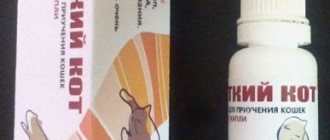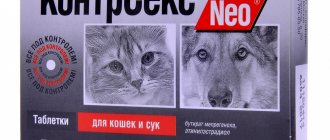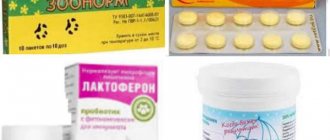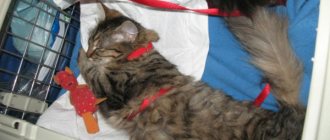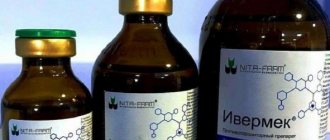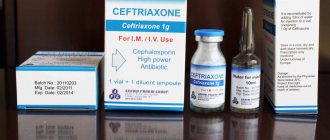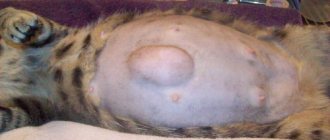All cats have episodes of vomiting.
Most often, this is cleansing the stomach of accumulated hair - a natural and familiar process. Infrequent vomiting is not a cause for concern. If this process is repeated and is accompanied by a refusal to eat and drink, then you need to contact a specialist, as the pet may become dehydrated. And to alleviate the animal’s condition, give it cerucal. Action of the drug. Irritated nerve receptors send impulses from the gastrointestinal tract to the vomiting center of the brain about food rejection. Cerucal is absorbed into the blood and blocks receptors, reducing the susceptibility of nerve endings and temporarily disabling the vomiting center. The functioning of the stomach and intestines is normalized: food is not retained, but is digested, and heaviness is relieved. The functioning of the gallbladder improves: bile production returns to normal. Spasm in the digestive organs is reduced. Hiccups are eliminated.
Causes of vomiting in dogs
Vomiting is a reflexive process undertaken by the body to cleanse the gastrointestinal tract.
In most cases, vomiting syndrome occurs due to various types of poisoning - the animal makes attempts to get rid of a foreign substance, body, etc. Vomiting in a dog occurs for reasons such as:
- reaction to a toxic or foreign substance (poison) entering the stomach;
- spoiled food;
- foreign object in the stomach or intestines;
- parasitic (helminthic) infestation;
- parasitic infections, such as piroplasmosis;
- diseases of the stomach, intestines, and other organs of the digestive or excretory systems;
- motion sickness in transport;
- eating grass to cleanse the intestines.
The last symptom may not mean anything - dogs often arrange “fasting days” for themselves, but if this phenomenon occurs frequently, it makes sense to think about checking the animal for the presence of inflammation or chronic diseases of the gastrointestinal tract.
If your dog vomits during or after a car ride, it is most likely motion sickness. To prevent motion sickness before the trip, it is recommended not to feed the animal, but to give it an anti-motion sickness medication, for example, Dramamine, Cerucal.
Forms of preparation
Cerucal is available in tablet and injection forms. The main composition of the drug includes metoclopramide hydrochloride. Auxiliary components when released in tablets are potato starch, lactose, gelatin, magnesium, silicon. The injection version of the drug, in addition to the main constituent substance, contains water for injection, sodium chloride, disodium salt, etc.
The main purpose of the medicine is to relieve vomiting syndrome. The drug is also used to enhance intestinal motility and gastric motility.
Origin of nausea in dogs
Nausea is not an independent disease. At best, this is a one-time nuisance; at worst, it is evidence of a chronic disease or poisoning.
In case of infrequent vomiting with suspected poisoning from poor-quality food, the dog should be given adsorbents: activated carbon, filtrum, endosorb. When the vomiting stops, you can give the dog chamomile infusion, use a course of Enterosgel, Bifidoc, etc. to restore the gastrointestinal tract. In this case, it is not forbidden to give a pill or give a cerucal injection to a dog.
However, any unusual behavior in the pet over the past day or three should alert the owner. It is necessary to remember whether the pet has eaten low-quality food or swallowed anything on the street. The cause of the urge to vomit in this case may not be food poisoning but poisoning.
Nausea can be caused by bone fragments or a foreign object (toy, splinter, cellophane, rope, etc.) stuck in the stomach, esophagus, even teeth. If you suspect this option, you should contact a veterinarian, have an ultrasound or X-ray, because the dog may not be able to get rid of the object that is bothering it on its own. A foreign object, a pathology such as volvulus, a bone that has damaged the esophagus - medical care not provided in time can cost the pet’s life.
Vomiting may be accompanied by an upset stomach - diarrhea, constipation due to refusal of food (sometimes water). In the case of diarrhea, we can talk about the toxic or infectious origin of vomiting - poisoning, enteritis. Dehydration caused by loss of fluid is extremely dangerous for the animal’s body, so you should urgently go to the clinic.
Before visiting the veterinary clinic, you can ease the animal’s condition a little by giving him an ice cube to lick. Next you need to give an injection of an antispasmodic or pain reliever. The instructions for cerucal for dogs state that it should be used intramuscularly at a dosage of 0.1 mg per 1 kg of animal body weight, after which go to the doctor. When the diagnosis is made, we can talk about the planned use of cerucal.
Dosage of the drug and signs of drug overdose in cats
The described dosage of the drug and signs of overdose are given as indicative. Under no circumstances should you prescribe or use medicine on your own, as this can lead to very serious consequences!
You need to remember one important nuance - this medicine is not for veterinary use. Initially, it was developed and created exclusively for medicine, and only then veterinarians “refined” the methods of using Cerucal in their practice.
When using the medicine in tablets, 0.5-0.7 mg of active substance for every 10 kg of animal weight. Considering that the tablet contains 10 mg of metoclopramide hydrochloride, it is simply impossible to adequately dose the drug in this case.
Cerucal dosage for dogs
Cerucal is available in two forms - tablets and solution for injection. If the drug is used to eliminate nausea, retching, vomiting, it is used in the form of an intramuscular injection or intravenous infusion (infusion). The infusion is carried out only by a specialist. When vomiting, use in tablet form is not effective, since the drug will come out back with the vomit.
It can be taken in tablet form for other indications. To help during X-ray and probe examinations, it is used in the form of a solution, taken orally.
One tablet and ampoule contains 10.54 mg of the main active ingredient, which corresponds to 10 mg of anhydrous metoclopramide. For a dog, the average dose for a single dose is 0.5-0.7 mg/10 kg of body weight. Can be used up to 3 times a day, the maximum dose of the drug within 24 hours is 1-2 mg/10 kg of body weight.
Most often, the course of treatment is 5-7 days.
If treatment within a week does not help, contact your veterinarian to prescribe another drug, since Cerucal has a rather severe effect on the body and its long-term use is contraindicated.
Trea 09/09/2013
I knew that Cerucal should not be taken for stool disorders in animals, but the fact that it is not prescribed to dogs under 8 months is new to me. This drug was injected at a veterinary hospital and a seemingly experienced, elderly veterinarian prescribed the injection at home to a three-month-old puppy; the dog was suspected of having distemper. Unfortunately, it was not possible to save the animal, it was due to a weak immune system, and after the article, doubts about the correctness of the prescribed treatment and the competence of the doctor are overwhelming.
MedvedWinny 08/24/2013
This article is written very professionally, detailed and interesting. This article is very useful for dog owners as they often face digestive problems in dogs. This article will help the owner identify the symptoms, set the time for taking this drug and the dosage so as not to harm the dog.
Kurban 08/06/2013
In general, it is better not to prescribe any medications to an animal on your own, because, for example, vomiting in itself is not a very alarming symptom. So, if your pet vomits, you don’t need to immediately stuff it with cerucal. It’s another matter if vomiting is repeated over and over again, becoming debilitating. But here you need to immediately take the animal to the doctor. The article will be very useful for those who, for some reason, do not have the opportunity to take their dog to the veterinarian as soon as possible.
mazepa 07/09/2013
The article contains important information, but it is worth noting that it is better to point out that any medicine, especially one that is originally intended for humans, cannot be used without a veterinarian’s indication, and this article is intended as informational information. Because if you read somewhere and start giving the medicine damn, there may be irreversible consequences.
annotation
Cerucal (in Latin - Cerucal) is a drug that most have not only heard of, but is also used by many for vomiting and nausea. It is prescribed by most doctors as an antiemetic and choleretic agent.
The drug is also actively used in veterinary medicine for dogs and cats after taking medications or before x-ray examinations.
The release form is presented in tablets or solution for injection.
Pharmacological group - medications used for problems of the gastrointestinal tract (gastrointestinal tract) - antiemetic.
Reviews from breeders about the drug
Cat owners note that Cerucal is quite effective against vomiting.
Alevtina. I had to treat my cat with Cerucal, and I was pleased with the results. My pet’s digestion returned to normal within a week, the vomiting stopped, and it was possible to gradually transfer him to his usual food without fear that his stomach would not accept it.
Svetlana. In addition to efficiency, I would like to note the convenience of using Cerucal. This remedy is available not only in tablets, but also in the form of an injection solution, which is very convenient when it comes to treating an animal, since not every cat is able to eat an unpleasant-tasting medicine. The solution is packaged in ampoules in ready-made form, it does not need to be diluted, and the drug can be stored for a long time, up to 5 years.
READ How to check if your cat is pregnant
Valentina. My cat often vomits due to gastrointestinal problems. Cerucal has become a real salvation for us, I use it every time her stomach does not accept food. Thanks to this remedy, the attacks are no longer as severe as before.
When is Cerucalh2 used?
1Use of the substance Omeprazole Orally, intravenously. Adult patients: duodenal ulcer; prevention of relapse of duodenal ulcer; stomach ulcer; prevention of recurrence of stomach ulcers; erosive and ulcerative lesions of the stomach and duodenum associated with Helicobacter pylori (as part of complex therapy); erosive and ulcerative lesions of the stomach and duodenum associated with taking NSAIDs; prevention of erosive and ulcerative lesions of the stomach and duodenum associated with taking NSAIDs, prevention of stress ulcers; reflux esophagitis; long-term monitoring of patients with cured reflux esophagitis; gastroesophageal reflux disease; Zollinger-Ellison syndrome. Application in pediatrics. Inside. Children over 2 years old with body weight ≥20 kg: reflux esophagitis; gastroesophageal reflux disease (heartburn and sour belching). Children and adolescents over 4 years of age: duodenal ulcer associated with Helicobacter pylori (as part of complex therapy).
> Analogues of Cerucal
Analogs: Metoclopromide.
How and where to give an injection to a cat
With incessant vomiting, there is a real danger of death, so sometimes, with the permission of a specialist, you have to inject Cerucal into the animal yourself; for this you need to know how and where to inject the cat correctly.
The antiemetic agent can be administered subcutaneously to animals, but to obtain the stated effect, only intramuscular or intravenous administration of the drug is allowed. Injections into a vein are given only by a veterinarian; the medication must be administered by drip with constant monitoring of the animal’s vital functions.
The owner can give the cat an intramuscular injection on his own, but a specialist should consult the owner about the dosage and possible side effects.
It is more convenient to place the injection in the thigh muscle; injection into the shoulder of a pet is also allowed. It is advisable to carry out the procedure with the participation of an assistant who will secure the animal to avoid injury to the owner.
Before the injection, you should thoroughly wash your hands with soap and draw the required amount of a single dose of Cerucal into the syringe, strictly following the specialist’s instructions. The animal must be restrained so that the hind limb is relaxed and flexed at the joint. The needle is inserted at a right angle with a clear, short movement, then the medicine is slowly injected, and the syringe is removed and the muscles of the animal.
Contraindications and restrictions
You should completely stop taking Cerucal if your cat has the following diseases:
- tumors, both benign and malignant;
- there are gastrointestinal bleeding;
- epileptic seizures occur;
- intestinal obstruction in case of blockage by foreign objects;
- intolerance of the animal to any components of the drug.
In addition, Cerucal is contraindicated in kittens, as the drug can cause irreparable damage to the liver.
The drug should be taken with caution in the following cases:
- renal failure;
- disturbances in liver function;
- animal pregnancy and feeding kittens.
In such cases, the drug should not be given independently, even for first aid. Only a veterinarian can calculate the dose correctly, and only under his supervision can Cerucal be given.
Optimal storage conditions
Since the medicine is quite strong (but is considered safe), the storage conditions recommended by the manufacturer must be followed exactly:
- The temperature should be maintained between 0° and 25°C. The liquid dosage form is stored at a temperature from 0° to 4°C (preferably in this range). It is not advisable to freeze the drug, but the manufacturer himself states that a single cycle of freezing and thawing does not affect the therapeutic properties of Cerucal in any way.
- It is very important to isolate the storage location from direct sunlight, since ultraviolet radiation has an extremely detrimental effect on the active ingredients of the medicine and quickly renders the latter unusable.
- Since uncontrolled use of this product is fraught with unpredictable consequences, it is necessary to store it in a place where it is guaranteed that pets and small children will not get into it.
Application of Cerucal for cats
"Cerucal" in cats is used for profuse vomiting that does not stop spontaneously. With a one-time regurgitation, there is no need for medication. It is considered normal for a cat to shed the fur accumulated in the digestive tract once a month along with vomiting, which she licks off herself.
The drug may be needed for the following diseases, in which vomiting becomes a serious danger to the cat’s life (causes dehydration):
- peptic ulcer of the stomach and intestines;
- reflux esophagitis;
- prolonged hiccups;
- dyskinesia of the bile ducts and inflammation of the gallbladder (vomiting is accompanied by the release of bile);
- helminths;
- poisoning with poor quality products.
As a means of increasing the tone of the intestinal muscles, Cerucal is used for:
- stomach atony;
- intestinal atony;
- loss of muscle contraction in the postoperative period.
Poisoning in a cat
Dosing of the drug for cats
The dosage of the medicine in tablets is carried out according to the proportion: per 1 kg of cat weight - 0.2-0.4 mg of Cerucal. Course duration is 3-5 days. Dosage in ampoules is carried out in a similar way.
Table 2. Indications for use and dosage of “Cerucal” for vomiting in cats.
| Indications for use | Dosage of the drug based on each 1 kg of cat weight |
| Peptic ulcer | 0.2-0.3 mg |
| Intoxication (helminthic infestation, poisoning) | 0.4 mg |
| Bile duct dyskinesia and cholecystitis | 0.3-0.4 mg |
| Reflux – esophagitis | 0.2 mg |
| Hiccups | 0.2 mg |
Instructions for use of "Cerucal" in cats
The medicine is injected subcutaneously at the withers. The skin is pinched and a needle and medication are inserted under it. Intramuscular administration is possible, the needle is inserted into the thigh area to a depth of no more than 1 cm. The maximum number of uses of the drug per day is 3 times. If the daily dose is exceeded, symptoms of overdose develop.
Injection into the cat's withers
How to give a cat an intramuscular injection at home? Why learn to give injections yourself? Advantages and disadvantages of intramuscular injections. We select syringes and needles for injections for cats. How to properly restrain your cat before injection. Injection technique. Possible complications in a cat after the injection. You will learn about this by reading the material on our portal.
Signs of overdose in cats
These symptoms can appear not only when the daily dose of the drug is exceeded (often happens when the dosage of “Cerucal” in tablets is incorrect), but also in case of individual intolerance to the active substance or components of the drug.
Overdose symptoms:
- loss of coordination, dizziness, auditory hallucinations;
- anxiety, desire to be constantly in the arms of the owner, unreasonable fear;
- stool disorders (of any nature);
- hormonal disorders;
- allergies.
Attention! If you are planning a cat pregnancy, then after using the drug you must skip one hunt (to restore hormonal levels)
Allergy in a cat
Contraindications to the use of Cerucal for cats
If your cat is sick with the following diseases, then it is strictly forbidden to give it “Cerucal”:
- ulcer perforation (rupture);
- CNS diseases: epilepsy, seizures;
- intestinal obstruction;
- oncology;
- individual intolerance to the drug and allergic reactions to its components.
The above diseases can be in a latent form when the owner is unaware of them. The use of "Cerucal" in these cases is detrimental to the animal. For this reason, prior consultation with a specialist is required before administering the drug. In emergency cases, try to call a veterinarian at home and not take independent action.
A sick pet brings a lot of trouble and anxiety to its owners and mistresses. Read our article and find out what diseases cats have and what signs indicate health problems in a cat.
Reviews:
Reviews about this medicine are quite good. Many people praise its high efficiency. However, when treated with injections, some animals developed serious health problems, so they should only be done under the supervision of a veterinarian. And check the compatibility of the cat’s body with its active ingredients.
Our cat Madonna suddenly began vomiting for a very long time. At the same time, we did not find any residues of fur in the vomit. We went to the vet, who discovered an intestinal disorder. After a thorough examination, he gave an injection and prescribed pills. After five days, my appetite appeared, and after a week the nausea went away. Now we know that we need to buy Cerucal to cure an animal with regular nausea and vomiting.
Video: what to do if a cat vomits?
Symptoms
Symptoms preceding the urge to vomit are not so numerous. However, we will still list the main signs indicating the presence of a feeling of nausea in an animal, followed by actual emptying of the stomach.
So, a pet’s eruption is preceded by such manifestations as:
- restlessness with pacing in a small area from one side to the other, like a tiger in a cage;
- noticeable excessive salivation in the dog;
- sometimes the urge accompanies a dog’s cough;
- possible stomach upsets with diarrhea, lethargy;
- the dog often burps, it is not difficult to understand that not everything is in order in the pet’s gastrointestinal tract;
- just before vomiting, the animal often licks itself; this is typical for all pets, not just dogs.
All these manifestations of nausea, causing vomiting in a pet, probably many had the opportunity to observe with their own eyes. This is especially true for anxiety and licking before the urge.
The connection between diarrhea and vomiting in a pet should also not be ignored. Most often, this indicates a general cause of problems in the body. It is clear that something is happening to the dog.
There can be a huge number of reasons.
Side effects when taking the drug
If the animal has kidney problems, then you should carefully monitor the dog’s body’s reaction to the drug. If you notice any discomfort, call a veterinarian immediately.
Any medication has side effects, Cerucal is no exception. This is expressed in the animal’s drowsiness, excessive fatigue and slow reaction to the actions taking place around it. Or, conversely, anxiety may increase and the dog’s heart rate may increase. Diarrhea may also occur. If you notice all or some of these symptoms in your pet, then you should discontinue the drug and contact your veterinarian to obtain qualified advice and prescribe another drug.
Vomiting in dogs is as common as in humans. Sometimes the urge to empty the stomach can be completely benign, and sometimes the desire to empty the womb can mean serious problems within the body.
If a dog’s vomiting in the morning causes a cough, the process is accompanied by loss of appetite, the dog experiences convulsions, all these are symptoms of certain pathologies. How to stop a dog from vomiting? What does it mean when a dog vomits white foam? Will Cerucal and Enterosgel help? What other antiemetic drugs can be used and how to treat a pet?
As you can see, there are many questions in connection with such an unpleasant phenomenon as vomiting in a pet. There are even more reasons why a dog empties its stomach by returning the eaten food through the esophagus, and not in a more natural manner.
Let's very briefly explain the mechanism of this unpleasant event. Why can a dog vomit in principle? Vomiting is known to be preceded by nausea. When there is a feeling of heaviness and obstruction in the gastrointestinal tract, the animal feels the need to empty it of food debris in the fastest way.
This is if we talk about conditionally controlled vomiting. Sometimes the dog cannot control himself completely, and the eruption occurs by itself, involuntarily.
There can be plenty of reasons for this, from specific needs that do not entail any continuation, to the presence of serious pathologies inside the body that require treatment.
Analogues of the drug
Sereniya is an effective and fairly safe drug against nausea and vomiting. The only disadvantage of this product is its high price - a 20-ml bottle of injection solution costs about five thousand rubles, and a package of four tablets costs about a thousand.
Serenia tablets can be purchased individually
True, in veterinary pharmacies you can usually buy tablets individually, and in some pharmacies they offer to buy not the entire bottle of solution, but to draw the required dose into a sterile syringe - but in this case there is a high risk of purchasing an expired product.
There are no complete analogues of Serenia. However, there is a fairly large selection of antiemetic drugs, primarily intended for people. After consulting with a veterinarian, you can choose a suitable remedy for your pet, which will cost significantly less than Serenia.
Table: antiemetics that can replace Serenia
| Drug name | Compound | Therapeutic purpose | Contraindications | Possible side effects | Estimated cost |
| Cerucal |
| nausea and vomiting of various origins |
|
| 1000 rubles for 10 ampoules of 2 ml solution for injection |
| Metoclopramide |
|
|
|
| 80 rubles for 10 ampoules of 2 ml of 0.05% solution for injection |
| Ondansetron |
|
|
|
| 150 rubles for 5 ampoules of 2 ml for injection |
| Chlorpromazine |
|
|
| lethargy; decreased appetite; convulsions; depression; heart rhythm disturbances; manifestations of allergies | 100 rubles for 10 ampoules of 2 ml solution for injection |
Photo gallery: functional analogues of the drug Serenia
Metoclopramide is the main active ingredient of the drug of the same name.
Cerucal is widely used as an antiemetic for humans and animals.
Chlorpromazine relieves gagging and enhances the effect of analgesics
Cats that should not use Cerucal
Not all animals can be prescribed Cerucal. For example, a direct contraindication is childhood. You cannot give Cerucal injections to a cat with the following diseases:
- intestinal obstruction;
- perforation in one or more gastrointestinal organs;
- stomach bleeding;
- the presence of malignant neoplasms;
- epilepsy;
- convulsive seizures.
Many breeders are concerned about the permissibility of giving Cerucal to pregnant cats during toxicosis. The answer from veterinary specialists: “No.” It is also undesirable to prescribe it to animals with respiratory problems or to small kittens.
To prevent vomiting in an animal, it is enough to visit a veterinary clinic at least once a year and have your pet examined.
In what case will Cerucal not help?
There are a lot of viral diseases for which the medicine will help stop vomiting, but will not affect the treatment of the animal in any way. If your cat starts vomiting, and this happens several times, you will need to seek help from a veterinarian, because these could be symptoms of a life-threatening viral disease. Poisoning can also cause vomiting. In this case, Cerucal for cats will help, but you will also need to give other medications that will help remove toxins from the body.
The use of "Cerucal" will be inappropriate if the animal's vomiting is caused by disorders of the vestibular apparatus or is of psychogenic origin. In such cases, the veterinarian prescribes completely different medications.
Cerucal for a dog when vomiting - dosage
Cerucal is an excellent remedy that is used for symptoms of nausea, vomiting in dogs and poisoning. The medicine exists in the form of tablets and injections. In case of vomiting, an intramuscular injection is necessary. The optimal dose for a dog is 0.5-0.7 milligrams per 10 kilograms of weight. This dosage is used three times a day, but with prior consultation with a veterinarian.
Take care of your pets, respond to their ailments and help cope with them!
Vomiting in dogs is as common as in humans. Sometimes the urge to empty the stomach can be completely benign, and sometimes the desire to empty the womb can mean serious problems within the body.
If a dog’s vomiting in the morning causes a cough, the process is accompanied by loss of appetite, the dog experiences convulsions, all these are symptoms of certain pathologies. How to stop a dog from vomiting? What does it mean when a dog vomits white foam? Will Cerucal and Enterosgel help? What other antiemetic drugs can be used and how to treat a pet?
As you can see, there are many questions in connection with such an unpleasant phenomenon as vomiting in a pet. There are even more reasons why a dog empties its stomach by returning the eaten food through the esophagus, and not in a more natural manner.
Let's very briefly explain the mechanism of this unpleasant event. Why can a dog vomit in principle? Vomiting is known to be preceded by nausea. When there is a feeling of heaviness and obstruction in the gastrointestinal tract, the animal feels the need to empty it of food debris in the fastest way.
This is if we talk about conditionally controlled vomiting. Sometimes the dog cannot control himself completely, and the eruption occurs by itself, involuntarily.
There can be plenty of reasons for this, from specific needs that do not entail any continuation, to the presence of serious pathologies inside the body that require treatment.
Dosage and method of administration
When prescribing Cerucal for cats, the dosage should be determined by the doctor. The veterinarian prescribes a treatment regimen and dosage of medication based on the facts he knows about the animal. Among them: age, weight, existing diseases, general health and others.
It is usually allowed to give your pet Cerucal 2-3 times a day. In this case, the dose of Cerucal for cats is calculated at 0.4 mg per kilogram of weight. Tablets of the drug are available in 10 mg doses. A cat weighing 5 kg will need to take a little less than a quarter of a whole tablet. Ampoule volume 2 ml.
The drug works best when taken on an empty stomach. A piece of the tablet is given to the pet 30 minutes before meals. First, the cat is wrapped in a towel to limit its movements. The animal must be held in such a way that its head is slightly raised. A tablet is placed in the open mouth closer to the root of the tongue. The mouth is closed and held closed until the cat swallows the medicine. The swallowing reflex can be triggered by blowing into the cat's nose. Next, the owner must calm the pet, give him something tasty, and pour fresh water into a bowl.
If a solution is used, the drug can be injected either into a vein or intramuscularly.
Contraindications
Cerucal (injections) is often used to stop vomiting in a child under two years of age, although this is prohibited. Tablets are used similarly for children under 14 years of age, usually also to get rid of vomiting.
Many mothers share information with each other about how they gave the drug to their child, advising them not to pay attention to the contraindications in the instructions, since nothing happened to their baby. Of course, no one wants anything bad when advising each other, but this is completely incorrect from a medical point of view.
It is strictly forbidden to use Cerucal for the following diseases and pathological conditions:
- Hypersensitivity to the active component or the drug in general.
- Lactose/galactose intolerance.
- Glaucoma.
- Intestinal obstruction.
- Arterial hypotension/hypertension.
- Gastrointestinal bleeding.
- First trimester of pregnancy (in the 2nd and 3rd trimester, use is allowed only for vital indications).
- Lactation.
- History of epilepsy, Parkinson's disease.
Before taking the drug, it is recommended that you read the full list of contraindications, which is presented in the official instructions.
Application of Cerucal for dogs
"Cerucal" is used in dogs for long-term incessant vomiting, when there is a threat of dehydration. It is advisable to use the medicine in consultation with a veterinarian, but in emergency cases it is permissible to administer it to the dog yourself. There will be no disastrous consequences for the animal if the dose is selected correctly (we will consider this issue in more detail below).
Dehydration in a dog
Causes of vomiting in dogs
Incessant vomiting occurs in dogs for the following reasons:
- peptic ulcer of the gastrointestinal tract;
- poisoning with stale food;
- parasites in the intestines;
- diseases of the central nervous system;
- cancerous tumors;
- the presence of a foreign object in the gastrointestinal tract;
- prolonged hiccups.
Indications for the use of the drug will be all of the above conditions, except for brain diseases. In this case, Cerucal can cause irreversible consequences and severe side effects.
Poisoning in a dog from poor quality food
Another indication for prescribing the medication will be studies of the gastrointestinal tract, when a probe (a device with a built-in video camera) is inserted into the dog’s stomach to examine the condition of the mucous membrane of the digestive organs. When it penetrates, a strong gag reflex occurs; the pet can interfere with the procedure. The veterinarian administers a prophylactic dose of Cerucal subcutaneously within 20-30 minutes. The same applies to x-ray examination of the dog. Before this procedure, a large amount of barium sulfate solution is injected into the stomach. It doesn't taste good and causes a gag reflex. The specialist successfully repays it using the described means.
Examination of the gastrointestinal tract in a dog
Dosing medication for dogs
The tablets are difficult to dose, but for large dogs their use is possible. There should be 0.5 active ingredient per 10 kg of pet weight. In 1 tablet its content is 10 mg. It is almost impossible to divide a tablet into 20 equal parts. Only if the dog weighs 20-30 kg can the dosage be carried out correctly.
Table 1. Indications for use and dose of “Cerucal” for vomiting in dogs.
| Indications for use | Dose of the drug for every 10 kg of dog weight |
| Peptic ulcer | 0.5 mg |
| Intoxication (poisoning, helminthic infestation) | 0.7 mg |
| Oncological diseases | 0.5 mg |
| Hiccups | 0.5 mg |
The maximum amount of medication that can be given to an animal during the day without causing an overdose is 2 mg per 10 kg of dog weight. The dose should be divided into 3 parts and given one at a time throughout the day.
Dosing the injection solution is easier and more accurate. 2 ml of solution (one ampoule) also contains 10 mg of the drug. You can measure the required amount of medicine using an insulin syringe according to the marks on its reservoir.
Instructions for use
It is very difficult to give tablets to a dog. When vomiting, it is difficult for the owner to understand how much of the drug was absorbed into the pet’s blood and how much came back out with vomiting. There is a high probability of overdose if the tablet is reintroduced into the esophagus. If there is no other option, then dissolve the tablet in a small amount of water and add the solution to a syringe without a needle. With its help, squeeze the dissolved drug onto the root of the dog’s tongue and give it to drink so that the unpleasant taste does not cause repeated vomiting.
Administering medication using a syringe without a needle
Injections are easier to give. The dosage of the drug is carried out using an insulin syringe. They also give the injection. At home, subcutaneous injection into the withers is preferable. The skin on it is pinched with your hands, and at the same time a needle and drug are inserted under it. You can put the medicine into the muscle on the thigh, the main thing is not to insert the needle deep, because it can touch the bone - this is painful for the dog.
Injection into the dog's withers
Injection into a dog intramuscularly
The course of treatment with Cerucal is 3-5 days, the duration of use can be increased in consultation with the doctor.
"Cerukal": description of the drug
The medicine is available in the form of tablets and solution for injection (for intramuscular, intravenous or subcutaneous administration). The speed at which the effect manifests depends on the method of taking the drug. When using the tablet, vomiting goes away after 30-40 minutes, when the solution is administered subcutaneously or intramuscularly - after 15-20 minutes. The fastest result is achieved in 2-3 minutes when the medicine is administered intravenously.
Attention! For cats and dogs, the medication is administered subcutaneously or intramuscularly. In emergency cases (in a veterinary hospital), an intravenous injection is given, which is not recommended to be done at home.
Release form
In the tablet, the medicinal substance is mixed with auxiliary components. Its dose per piece is 10 mg. The same dosage is contained in one ampoule, in which the medication is presented in dissolved form in combination with preservatives and solvents. Total volume – 2 ml. Due to the difficulties of dosing the drug in tablets in animals, the dissolved form is more often used.
Packaging of "Cerucal" in tablets of 10 mg
The tablets are packaged in a plastic jar with a label attached. The vial is enclosed in a cardboard box, which contains primary data about the drug: name, dose, manufacturer. Ampoules are sold in 10 pieces (also packed in a cardboard box). Inside they are on special plastic supports, 5 pieces each.
Packaging "Cerucal" in ampoules of 2 ml
Mechanism of action of the drug
"Cerucal" affects the vomiting center in the brain and inhibits its activity. It blocks vomiting impulses. Additionally, the drug has an effect on the smooth muscles of the gastrointestinal tract - it tones it, therefore it is used not only as an antiemetic, but also as a medicine for reducing intestinal tone. For example, after surgery.
The medicine eliminates the symptoms of the disease, but does not cure it. Its use must be justified.
Important! Vomiting is a signal of deep damage to the body; before eliminating it, it is necessary to diagnose the cause of the disease in order to begin its treatment. It is a mistake to assume that once the vomiting has been eliminated, the animal has recovered; it still needs the help of a veterinarian.
Intoxication in a dog
Contraindications and side effects
Despite the high effectiveness of the drug, there are a number of contraindications, which include:
- Bleeding in the digestive system.
- Hypersensitivity to the components of the drug.
- Intestinal obstruction.
- Children under 3 years of age.
- Epilepsy.
- Arterial hypertension.
- Bronchial asthma.
- Liver and kidney diseases.
Side effects occur when the medication is taken incorrectly or the dosage is exceeded. Negative consequences appear in the form of urticaria, drowsiness, weakness, dry mouth, dizziness. Such phenomena go away on their own and do not require treatment. However, if they do not go away within a few hours, you need to contact a specialist for help. You can avoid negative consequences if you follow the instructions.
Indications for use
The main indication for the use of Cerucal in cats is vomiting, which occurs due to infectious and non-infectious pathologies of the gastrointestinal tract, traumatic injuries, motion sickness, reactions to the administration of drugs, dysfunction of the liver and kidneys
In addition to stopping gagging, veterinary specialists prescribe an antiemetic drug in the following cases:
- Metorism;
- hiccups, heartburn, belching;
- prevention of motion sickness in transport;
- preparation for x-rays and probing of the digestive system;
- gastrostasis;
- dyskinesia;
- weakness of the stomach muscles in diabetes mellitus.
Before prescribing Cerucal, you should consult your doctor; the drug has a number of contraindications in which the use of an antiemetic is unacceptable.
Cerucal dosage for dogs
Cerucal is available in two forms - tablets and solution for injection. If the drug is used to eliminate nausea, retching, vomiting, it is used in the form of an intramuscular injection or intravenous infusion (infusion). The infusion is carried out only by a specialist. When vomiting, use in tablet form is not effective, since the drug will come out back with the vomit.
It can be taken in tablet form for other indications. To help during X-ray and probe examinations, it is used in the form of a solution, taken orally.
One tablet and ampoule contains 10.54 mg of the main active ingredient, which corresponds to 10 mg of anhydrous metoclopramide. For a dog, the average dose for a single dose is 0.5-0.7 mg/10 kg of body weight. Can be used up to 3 times a day, the maximum dose of the drug within 24 hours is 1-2 mg/10 kg of body weight.
Most often, the course of treatment is 5-7 days.
If treatment within a week does not help, contact your veterinarian to prescribe another drug, since Cerucal has a rather severe effect on the body and its long-term use is contraindicated.
Trea 09/09/2013
I knew that Cerucal should not be taken for stool disorders in animals, but the fact that it is not prescribed to dogs under 8 months is new to me. This drug was injected at a veterinary hospital and a seemingly experienced, elderly veterinarian prescribed the injection at home to a three-month-old puppy; the dog was suspected of having distemper. Unfortunately, it was not possible to save the animal, it was due to a weak immune system, and after the article, doubts about the correctness of the prescribed treatment and the competence of the doctor are overwhelming.
MedvedWinny 08/24/2013
This article is written very professionally, detailed and interesting. This article is very useful for dog owners as they often face digestive problems in dogs. This article will help the owner identify the symptoms, set the time for taking this drug and the dosage so as not to harm the dog.
Kurban 08/06/2013
In general, it is better not to prescribe any medications to an animal on your own, because, for example, vomiting in itself is not a very alarming symptom. So, if your pet vomits, you don’t need to immediately stuff it with cerucal. It’s another matter if vomiting is repeated over and over again, becoming debilitating. But here you need to immediately take the animal to the doctor. The article will be very useful for those who, for some reason, do not have the opportunity to take their dog to the veterinarian as soon as possible.
mazepa 07/09/2013
The article contains important information, but it is worth noting that it is better to point out that any medicine, especially one that is originally intended for humans, cannot be used without a veterinarian’s indication, and this article is intended as informational information. Because if you read somewhere and start giving the medicine damn, there may be irreversible consequences.
The active substance is metoclopramide hydrochloride monohydrate
.
1 tablet contains 10.54 mg of this substance, which is equivalent to metoclopramide hydrochloride
is 10 mg.
Additional substances are: silicon dioxide, potato starch, gelatin, magnesium stearate and lactose monohydrate.
1 ml of solution contains 5 mg of metoclopramide hydrochloride
. Additional substances are: disodium edetate, injection water, sodium sulfite, sodium chloride.
Compound
In any form of release, the medicine consists of:
- silicon dioxide;
- gelatin;
- magnesium stearate;
- lactose monohydrate;
- potato starch.
In addition, the drug consists of additional (auxiliary) elements, namely:
- physiological solution;
- sodium chloride;
- edetate disodium;
- sodium sulfite.
Cerucal solution
How does Cerucal work on a cat?
The mechanism of action of Cerucal is based on blocking serotonin and dopamine receptors in the brain.
The active substance of the medicine, i.e. Metoclopramide acts very selectively, and therefore there are usually no other consequences of using the drug:
- Due to the blocking of the corresponding receptors in the animal, the sensitivity threshold of the vomiting center (which is also located in the brain) sharply increases.
- The animal's feeling of nausea disappears.
- Appetite returns.
- The cat no longer vomits after eating.
- The tone of the pet's lower stomach and sphincter improves, which helps improve overall intestinal motility. This has a beneficial effect on the process of digestion of food and the general condition of the animal.
- The synthesis of bile and its release into the lumen of the duodenum is normalized. This effect of Cerucal allows some veterinarians to use it as a means to prevent cholecystitis.
- The medicine promotes the synthesis of prolactin and improves the process of milk secretion and release.
The active substance is actively processed in the liver and 50% is eliminated from the cat’s body within 5 hours. But! It must be remembered that in cats with kidney pathologies, the therapeutic concentration of the drug in the blood can remain for almost 28 hours.
The drug (despite metabolization in the liver) is almost 100% excreted by the kidneys within the first 19 hours from the moment of administration. When treating cats, you must also remember that the active substance of the drug can easily pass through the blood-brain and placental barriers, and also enter breast milk completely unchanged.
Composition of the drug
The composition of the drug includes main and auxiliary components.
The main (i.e. active) compound is metoclopramide hydrochloride monohydrate:
- It has a pronounced antiemetic effect.
- Initially, metoclopramide was used by doctors to treat migraines, i.e. the substance is capable of blocking spastic attacks of pain.
- Accelerates the removal of semi-digested food from the stomach into the small intestine, without causing diarrhea (but there are nuances, which we will discuss below).
The following are used as auxiliary components (depending on the dosage form):
- Starch.
- Milk sugar (lactose).
- Gelatin.
- Silicon, magnesium and sodium compounds (including regular sodium chloride).
- Additional purified water for injection is used as the basis for the liquid dosage form.


